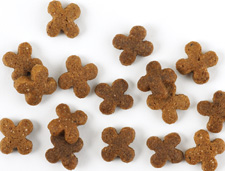
1. Nutrients vs. Ingredients: Understanding the Difference
First, we need to recognize that nutrients are not the same thing as ingredients. The quality of your dog’s diet isn’t determined by the ingredients alone. It’s the blend of nutrients that truly matters. Meeting your dog’s nutritional needs depends on the right nutrient balance, not just the ingredient list. The ingredients in dog food only have to do with digestibility and palatability. A given dog food can contain certain ingredients that have no nutritional value or that can’t be digested by your dog. You can find two different dog foods that may both seem to nutritious, but one may have ingredients that are better for your particular breed of dog. You should discuss your dog’s nutritional requirements with your vet to select a diet that provides everything needed.
2. The Importance of Tailoring Your Dog’s Diet
Healthy feeding habits should start as soon as you bring your dog home! Your dog’s diet influences such things as health status, appearance, development, and attitude. The way you feed your dog will affect certain behavioral aspects like potty training and begging. When your dog is a puppy, it is crucial to prevent it from gaining a lot of weight, which may contribute to the likelihood of obesity and its related health problems as they age.
 Since dogs come in all sizes and shapes, there are specific foods available that you should consider depending upon if it’s a small breed, large breed, puppy or adult. The nutritional needs of dogs will change as they age depending on how active they are. For instance, small dogs tend to require more calories per pound than larger dogs and thus need a dog food that provides a lot of energy.
Since dogs come in all sizes and shapes, there are specific foods available that you should consider depending upon if it’s a small breed, large breed, puppy or adult. The nutritional needs of dogs will change as they age depending on how active they are. For instance, small dogs tend to require more calories per pound than larger dogs and thus need a dog food that provides a lot of energy.
3. Concerns About Commercial Dog Food and Ingredient Safety
As of late, many dog owners have become gravely concerned about the safety of commercial pet food. With all the recent pet food recalls, many more dog owners are starting to prepare their nutritious dog foods. There is more than a little concern about how poorly regulated the pet food industry is concerning preservatives. Commercial dog food makers add all kinds of chemicals to keep their foods from deteriorating while sitting on the grocery store shelves. The Association of American Feed Control Officials (AAFCO) Official Publications lists 35 known preservatives being used by commercial dog food companies. Some of these have no restriction on the amount that can be added to your dog’s food. Chemicals such as Butylated Hydroxyanisole and Ethoxyquin have controversial safety reputations at best.
Many of the commercial dog food formulations contain meat and bone meal, which has been shown to contain the remains of euthanized cats and dogs. These dead animal bodies are sent to rendering plants, along with road kill and dead live stock. At the plants, they are boiled down to get the fat, which is sold to dog food manufacturers as “animal fat.” The leftover animal parts are dried, crushed and sold to the same manufacturers as “meat and bone meal.” Knowing this, many dog owners have put their pets an on the raw diet or started making their homemade dog food.
4. The Debate Between Raw and Homemade Diets
Those who advocate raw diets say it is the most natural because canines in the wild are carnivores and have survived and thrived for millions of years. They indicate that ever since commercial dog food appeared on the scene about 60 years ago, the increase in dysplasia, allergies and other health conditions in dogs has increased dramatically. However, proponents of homemade dog food say that dogs are omnivores, and they need the nutritional benefits of grain. They intimate that dog owners who use only raw food are depriving their dogs of valuable nutrients. Also, with homemade foods, you can be creative while making your healthy dog food. Proponents of homemade food report the activity as a fun way to feel even closer to their dogs. Especially if they like what you make.
5. Risks of Artificial Ingredients, Preservatives, and Cheap Fillers
5.1 Artificial Dyes in Kibble
Artificial ingredients are also used by well-known dog food brands. This may be harmful to their health. Kibble shouldn’t be “colored” with artificial dyes like yellow or red or any of the dye “numbers”.
5.2 Chemical Preservatives and Their Impact
Chemical preservatives are often used in new kibble for dogs. BHT (Butylated Hydroxytoluene), BHA (Butylated Hydroxyanisole), and Ethoxyquin are preservatives commonly used in dog food. These chemicals prevent food from going rancid. However, their safety in pet food is often questioned. These chemical compounds can harm your dog’s immune system. Look for natural alternatives like tocopherols instead. They are safer for your pet’s health.
5.3 The Issue with Wheat and Corn Fillers
Unfortunately, wheat and corn are used as cheap fillers in dog food. Some manufacturers use these as protein sources. They are often very hard for the animal to digest and can cause such allergies leaving your canine suffering from itching their ears, licking paws, hot spots, skin and coat issues and just plain old misery. These ingredients can be found in treats as well. Large manufacturers also make food in such large batched that you may never really know when the food was made or worse how fresh the food is you just purchased.

5.4 The Long-term Effects of Inferior Ingredients
Like humans dogs are what they eat. Artificial ingredients, poor protein sources, lack of fruits and vegetables all play a part in the immune system of you canine to fight off free radicals. When food is made of inferior ingredients, a whole list of things can affect your dog from allergies to disease.
5.5 Recognizing the Signs of Poor Nutrition
At first, when you feed your dog inferior foods there may or may not be apparent reasons to think there are issues. As time goes on, scratching may appear or constant ear infections or something of that nature. Luckily you will have the choice to search for a better nutritional food to alleviate these issues. If left untreated your pet’s immune system could be compromised, and a host of items like kidney problems, urinary tract issues, and joint issues, lack of energy and behavior changes could start to manifest.
6. Building a Healthy Foundation for Your Dog
It is wise to start your dog as young as possible with a premium natural food to build a healthy immune system and foundation for stable health. If that isn’t the case, then it is never too late to get on the right track of excellent nutrition. Healthy food along with pure water, plenty of exercise and lots of love all play a vital role in the health and longevity of your dog’s life.

